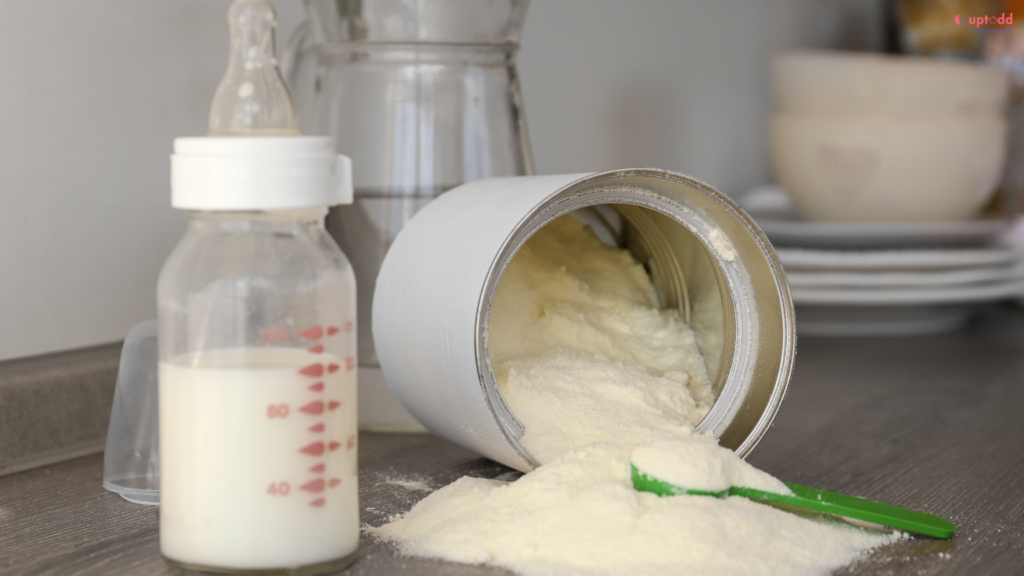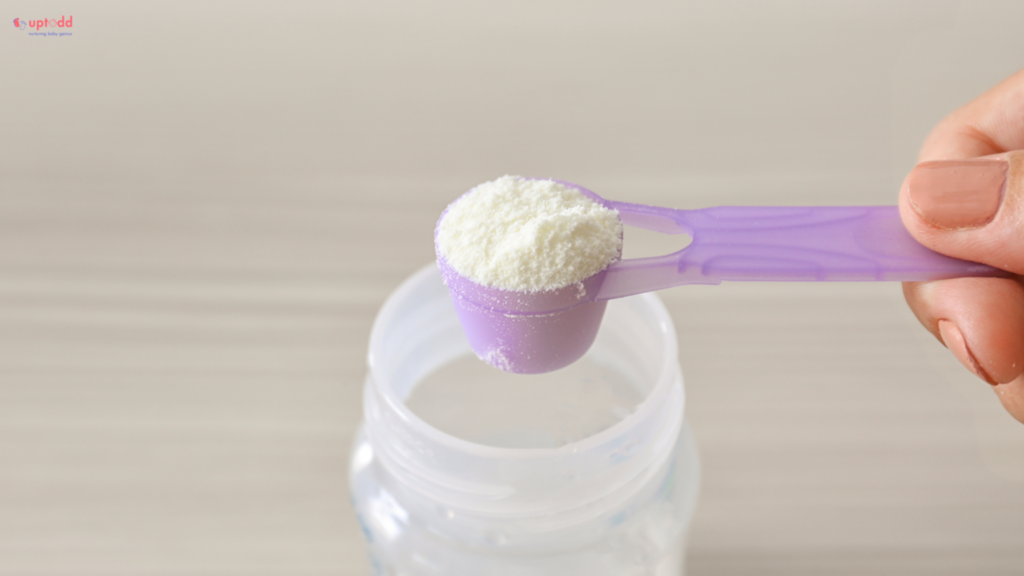
Formula Milk – A good alternative?
Topic
Formula Milk – A good alternative?
May start as early as
Birth
─────────
The choice between breastfeeding and formula feeding is a difficult one to make, especially when there is so much evidence on the benefits of breastfeeding. Many medical professionals believe that breast milk is the best nutritional choice for babies. However, breastfeeding is not a possible choice for many mothers. Personal circumstances such as medical conditions, comfort levels, and lifestyle factors often make breastfeeding challenging or even impossible. Consequently, in these cases, formula milk becomes a healthy and reliable alternative. For mothers who cannot breastfeed or choose not to, infant formula provides a safe, nutritious option that supports their baby’s growth and development.
In this blog, we will explore:
- Is formula milk good for babies when compared to breastmilk?
- When should I give my baby formula milk?
- Does baby formula contain the essential nutrients?
- How many times a day should I give formula milk to my baby?
- Does formula feeding result in less attachment with the baby?
- Can I make formula milk at home?
- What are some challenges of formula feeding
- Can I give both breast milk and formula milk to my baby?
Understanding the formula milk and feeding

Commercially prepared infant formulas are a nutritious and healthy choice for babies. Furthermore, it serves as a beneficial alternative to breast milk, as it contains a combination of proteins, sugars, fats, and vitamins that replicate mother’s milk. Some formula milk even contains some vitamins and nutrients that are not available in breast milk but are important for babies.
While breast milk is undeniably rich in essential nutrients and antibodies, modern baby formulas are formulated to provide a balanced and nutritionally complete diet for growing infants. Manufacturers adhere to strict regulations and quality standards to ensure that infant formulas contain the necessary nutrients for healthy development.
Formula feeding also allows for precise measurement and control of nutrient intake, making it easier to monitor a baby’s growth and ensure they’re receiving adequate nutrition.
Reference from Infant Nutrition: The First 6 Months
Reasons to choose formula milk

Lactational complications
- Inadequate milk supply
- Baby not satisfied by nursing
- Pumping is painful and difficult
Medical issues (babies)
- If the baby is not gaining weight
- Extensive neonatal intensive care unit (NICU) stay
Medical issues (mothers)
- Starting birth control or other prescription medications
- Breast hypoplasia or glandular dysfunction
- Some other medical concerns
Personal conflicts
- It is too difficult and stressful
- Working mother
- Negative experience with breastfeeding
Nutritional contents in formula milk

Most commercial formulas are made from cow’s milk. Additionally, they are fortified to resemble breast milk and provide babies with all the nutrients they need for healthy development. These nutrients include:
- Carbohydrates, in the form of the milk sugar “lactose”
- Iron
- Protein
- Minerals, such as calcium and zinc
- Vitamins, including A, C, D, E, and the B vitamins
- Essential fatty acids like ARA and DHA are important for the baby’s brain and vision.
- Breast milk contains nucleotides, the building blocks of RNA and DNA, and some formulas also include them to create a healthy alternative to breast milk. The baby’s Nucleotides boost the baby’s immune system and help the digestive organs develop.
- Prebiotics and probiotics – The probiotics are the “good” bacteria that fight against the “bad” bacteria that cause infection. Prebiotics promote the growth of these good bacteria in the gut. It also prevents babies from getting the skin condition eczema.
Reference from Infant Nutrition: The First 6 Months and Comparing Infant Formulas with Human Milk
When and how much is to be given?

Formula feeding should be done as per the baby’s needs, not on a predetermined schedule. Look for hunger and fullness signs that your baby gives, such as taking the fist or fingers to the mouth, smacking, or licking lips. These cues are helpful to understand when and how much to feed.
Usually, most healthy formula-fed newborns feed about every 2–3 hours. As they grow, they usually consume formula milk about every 3–4 hours. Slowly, they will follow a more predictable feeding routine and go longer stretches at night without needing a feed.
The baby should be You should give a 1-month-old baby around 56 to 120 grams of formula per feeding, and feed the baby 6 to 8 times in 24 hours.
At the age of 2 months, a baby should be given around 140 to 170 grams of formula per feeding. The baby should be fed 5 to 6 times in 24 hours.
From 3 to 6 months, a baby should be given around 170 to 200 grams of formula per feeding. The baby should be fed 5 to 6 times in 24 hours.
The amount of formula milk that the baby consumes will decrease as the infant increases intake of solid foods after 6 months. You should give formula milk during the first year of life, as it provides an essential source of calories, protein, calcium, and vitamin D.
Reference from Infant Nutrition: The First 6 Months
Are homemade formulas safe?
The answer is simply, NO. In fact, commercial formulae, manufactured under sterile conditions, aim to replicate mother’s milk by combining complex proteins, carbohydrates, fats, and vitamins that cannot be produced at home, fulfilling the requirement of babies for a balanced and particular set of nutrients. So, if you use formula, it is important to use only commercially made formula and avoid making your own at home.
Reference from Infant Nutrition: The First 6 Months
Will my baby become less attached?

No, attachment is an emotional bonding that can be achieved in many different ways. However, breastfeeding is not the only way to build that bond. Here are a few ways that you can build a secure attachment with your baby without breastfeeding:
- Skin-to-skin contact
- Holding the baby face to face, making eye contact, and smiling at your baby
- Talking or singing to your baby in a soft voice
- Holding your baby, or babywearing
- Talk to your baby while formula-feeding
Disadvantages that come with formula feeding
- Lack of antibodies in formula, which are only present in mother’s milk
- Is expensive
- May cause constipation or gastric issue in baby
Combination feeding

Some pediatricians may recommend a mixture of both breastfeeding and baby formula. supplementing with formula can help ensure that infants receive adequate nutrition while alleviating the stress and pressure associated with exclusive breastfeeding.
Formula feeding is also recommended by pediatricians along with breastmilk for better growth and weight gain. It has positive results in term of weight gain when compared to breast milk in preterm and low birthweight infants.
Additionally, combination feeding allows parents to address specific concerns or medical conditions that may impact breastfeeding. For example, mothers taking certain medications or undergoing medical treatments may opt to supplement with formula to reduce any potential risks to their infants.
Reference from Breastfeeding vs. Formula Feeding
Final Words

In the ongoing confusion regarding infant feeding practices, it is important to recognize the benefits of formula feeding. Formula feeding is a practical, necessary, and valuable option for many families. While breastfeeding undoubtedly offers unique benefits, formula feeding provides accessibility, convenience, and nutritional consistency, making it a practical choice for diverse parenting circumstances.
Always remember that what matters most is not the method of feeding but the love, care, and nurturing you provide to your baby, regardless of how you choose to nourish them.
Research & Resources
- https://www.webmd.com/parenting/baby/nutrition
- https://www.webmd.com/parenting/baby/nutrition
- https://www.ncbi.nlm.nih.gov/books/NBK215837/
- https://www.webmd.com/parenting/baby/nutrition
- https://www.webmd.com/parenting/baby/nutrition
- https://www.webmd.com/baby/breastfeeding-vs-formula-feeding
- https://www.webmd.com/baby/breastfeeding-vs-formula-feeding





